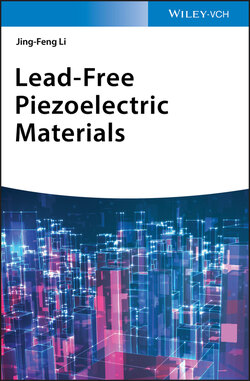Читать книгу Lead-Free Piezoelectric Materials - Jing-Feng Li - Страница 11
Оглавление
Foreword by Professor Jürgen Rödel
Piezoelectricity allows the generation of electrical charges on the surface of certain insulating materials in response to applied mechanical stress or, conversely, allows the generation of mechanical strain when subjected to an applied electric field. With such functionality, piezoelectric materials have been increasingly used nowadays in a wide range of technologies, as an intermediary between mechanical and electric energies. Typical examples include piezoelectric sensors and actuators in smartphones, piezoelectric probes in ultrasonic diagnostic machines, piezoelectric buzzers in industrial machines, and consumer electronics including toys, high‐precision positioning units in scientific research equipment, ignitors for lighters, pressure sensors, and so on. PbZrO3–PbTiO3 solid solutions have formed a major commercial system, abbreviated as PZT. The PZT‐based ceramics have dominated the market for about 70 years because of their excellent piezoelectric properties and a mature understanding of the processing technique. However, this “king” of piezoceramics has been challenged by the awareness of environmental protection, as European Union (EU) issued legislation on the restriction of hazardous substances (RoHS) in electrical and electronic equipment at the beginning of this century. RoHs and many other similar legislations throughout the world have stimulated the research searching for high‐performance lead‐free piezoceramics.
Significant progress has been witnessed in the past two decades. For select applications, replacements for PZT are being made available and some new materials even have advantages to PZT. For example, some of them feature higher fracture toughness, higher thermal conductivity, or simply lower density. However, transition into application demands from companies to run two production lines, one for PZT and one for the new material and customers need to be convinced. At present, there is no single system that can fully replace PZT. Nevertheless, there are competitive lead‐free substitutions, such as (K,Na)NbO3 (KNN), (Bi0.5Na0.5)TiO3 (BNT), and BaTiO3‐based (BT) systems. Prof. Jing‐Feng Li has been working mainly on the KNN system, while my group is working on the BNT system. Interestingly, both systems have complementary piezoelectric properties: KNN‐based ceramics possess high quasi‐static or small‐signal piezoelectric coefficients, whereas large piezoelectric strains can be achieved in BNT‐based ceramics. For many years, we had intimate collaborations on research projects and academic exchange. I would like to mention how amazing our collaborations are, especially once we both worked as guest co‐editors for a special issue about lead‐free piezoelectrics in MRS Bulletin in August 2018.
I am very pleased to know that Prof. Jing‐Feng Li has completed the writing of a specialized book on lead‐free piezoelectric materials, which is truly a tough yet important task for our community. This comes at exactly the right time where first high‐volume applications are expected in the next three years. I noticed that this book has two introductory chapters about the fundamentals of piezoelectricity and lead‐free piezoelectrics. I particularly like the detailed descriptions on measurement technology, which is so important to newcomers into this field. The second chapter gives an overview of the lead‐free piezoelectrics, including the background, the general classification, and the research progress of the lead‐free piezoelectrics. These two chapters should be very helpful for young researchers who have just started working on research topics related to ferroelectrics and piezoelectrics. Four representative lead‐free piezoelectric systems are introduced in the later chapters, which are then followed by a final chapter about lead‐free piezoelectric applications. Such an arrangement is excellent. Explanations are clear, diagram and sketches are simple but insightful, and references are well‐chosen and complete.
This book is not meant as a stand‐alone. Scientists and engineers need to consider a basic book on ferroelectrics for all the fundamental physics and possibly a book on applications. However, this book by Jing‐Feng Li is a definite must‐read for graduate students and young researchers working on the research topics related to lead‐free ferroelectric and piezoelectric materials. It suffices both as an introduction to the field as well as the first application‐oriented book on piezoceramics. This work should also be a valuable reference for the industry who wishes to obtain a comprehensive picture of the development status of lead‐free piezoceramics.
Jürgen Rödel
Professor, Department of Materials and Earth Sciences,
Technical University of Darmstadt, Germany
Guest Professor at Tsinghua University and Tokyo Institute of Technology
Member of German National Academy of Science and Engineering
